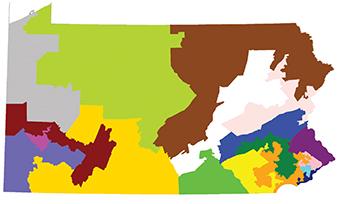Redistricting Efforts Aim to Take a Little of the Ugly Out of Elections
It’s November, and chances are you’re about to go to the polls, or you’ve already been. You might have voted, but you didn’t really choose your elected officials. Thanks to gerrymandering, they chose you.
Gerrymandering is the process of creating voting districts in a way that gives an advantage to one political party over another. It results in some pretty weird-looking districts. For example, Pennsylvania’s 7th Congressional District has been said to resemble Goofy kicking Donald Duck. It includes parts of six counties: Philadelphia, Montgomery, Delaware, Chester, Berks, and Lancaster. Not that all the other districts make sense. (See the map; that's the 7th in orange.)
Based on the U.S. Constitution’s requirement that each congressional district have about the same number of people, districts can be redrawn every 10 years, after the census is taken, to account for shifts in population. That sounds pretty innocuous, but the way the district lines are drawn is not. Current laws allow the party in power to control the process; this is one of the reasons it’s so difficult to unseat an incumbent.
Gerrymandering and redistricting reform have been in the news a lot lately. On Oct. 3, the U.S. Supreme Court heard a case called Gill v. Whitford, in which citizens of Wisconsin challenged the constitutionality of the 2011 redistricting in their state. A lower court found that the plan was, in fact, an unconstitutional partisan gerrymander. The districting plan is so partisan that the Republicans secured 60 Wisconsin State Assembly seats, compared with 39 for the Democrats, even though Republicans won only 48.6 percent of the vote. Up until now, the Supreme Court has been reluctant to hear cases dealing with the partisan nature of redistricting, so the fact that it took this case is a pretty big deal.
Wisconsin isn’t the only state where gerrymandering is an issue, and Republicans aren’t the only ones who benefit: Maryland is gerrymandered in favor of Democrats. According to the Brennan Center for Justice at NYU Law School, Pennsylvania is one of the three most-gerrymandered states in the nation. (The others are Michigan and North Carolina.) Although registered Democrats outnumber registered Republicans 48 percent to 38 percent, Republicans hold 13 of Pennsylvania’s 18 congressional seats.
There’s a movement to change the law that governs redistricting in Pennsylvania. It would require a change in our state constitution — an arduous process, to say the least. Obviously, the party in power thinks the current system is just fine. The first step toward redistricting reform in Pennsylvania is passage of a bill in the General Assembly, and several bills to reform redistricting have already been introduced.
Fair Districts PA, a non-partisan coalition working to end gerrymandering in our state, has been working in Harrisburg to support Senate Bill 22 and its house counterpart, House Bill 722. These bills would create a commission that would be responsible for redrawing district maps based on the census. This commission would be independent, impartial, transparent and ethically bound.
Want to know more? Want to get involved? FDPA has working groups throughout the state, including several in Philadelphia. The Northwest Philadelphia Working Group is one of the most active, and we welcome you to join us. You can go to the website (www.fairdistrictspa.com) and sign up, or come to one of our monthly meetings. (Feel free to contact me for more information.) We would also be happy to give a presentation to any group you’re involved with. You can often find us tabling at neighborhood events, with our beautiful (or not-so-beautiful, if you consider the ugliness of gerrymandering) puzzle-map of Pennsylvania’s congressional districts. Stop by; we often have postcards you can send to your state senator and representative expressing your support for SB 22 and HB 722.
“Gerrymandering,” by the way, is named after Gov. Elbridge Gerry of Massachusetts, who, in 1812, supported a bill that created a district near Boston that looked like a salamander. More than 200 years later, it’s time to end the practice, at least in Pennsylvania.
Contact Weavers Way member Sue Wasserkrug at wasserkrug@gmail.com.

